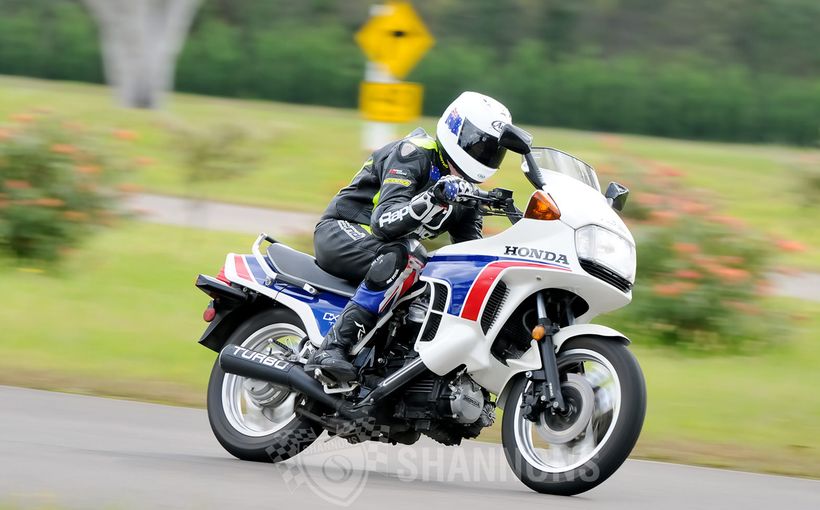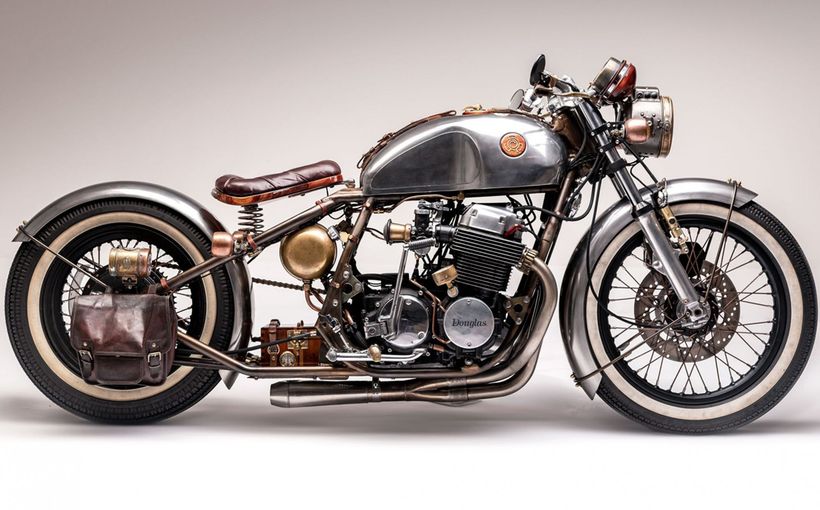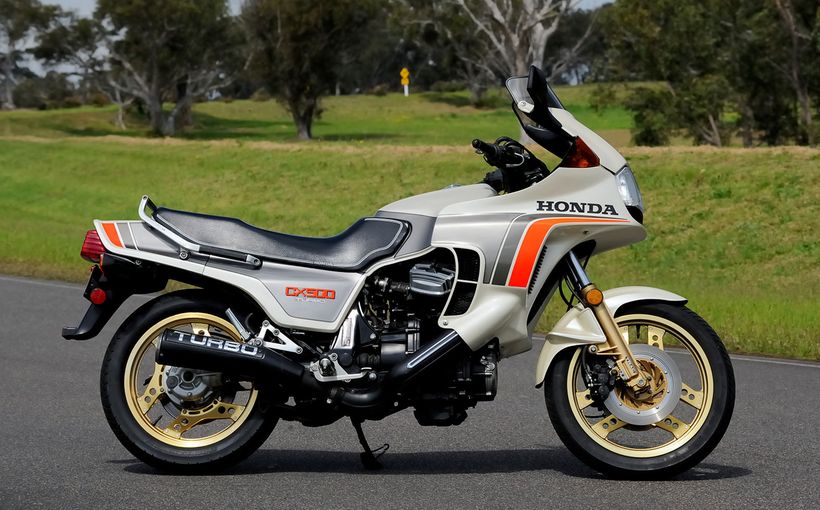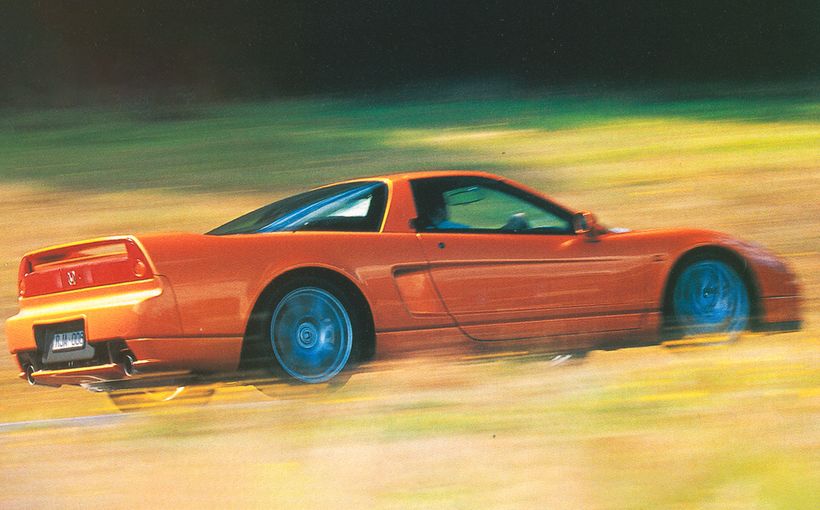
You're nestled in the NSX's ankle-high bucket seat, the engine broadside behind your back, no more than a few centimetres from your ears. Welcome to the front row.
It ain't Nashville inside Honda's NSX. The new 3.2litre V6 sounds nothing like the good ol' noise of a good ol' boy's V8. It's throaty, hard but not harsh; the cams at full vibrato accompanied by the just-audible buzz from the gearbox. The sound pitches near perfect at the hot end of the rev range where the induction of the V6 making power overwhelms the CD player. Turn off the stereo and listen.
Symphony? Crescendo? Musical labels are too pretentious, better left in the thesaurus. The growl and gnash of the NSX's powerplant swallowing a roomful of air every minute could be simulated by taping a Hoover to your head.
At 8000rpm, the all-aluminium, VTEC-controlled, 3179cm3 V6 is sucking roughly 14,500 litres of air per minute while pushing out 206kW and 298Nm.
It's a lightweight by supercar standards, but then Honda has achieved so much with so little in the '97 NSX. And subtly, too.
When the NSX appeared in 1990, it came as a statement of Honda Motor Corporation's capabilities. The NSX was built for one reason. Honda could. That was also the year Senna and McLaren-Honda won six F1 Grands Prix to give Honda its fourth straight championship as an engine builder. History is significant if only because it provides Honda with a racing heritage and proves its engineering ability. Honda followed the NSX with the oval-piston, eight-valves-per-cylinder NR750 motorcycle. With great dedication and expense, it had expanded its sphere of thinking beyond the accepted norms of conventional technology.
Today, the NSX struggles to keep pace with the very driveable and quick Ferrari F355, and on cost the $206,790 NSX is not as desirable as BMW's $131,750 sedan-de1ived M3. On face value, the NSX's seven-year edge needed sharpening, and Honda is playing an obvious game of supercar catch-up.
The interior has not aged with style. The dash, especially, needs a cut and tuck to bring back a youthful appearance. Function isn't the problem. All the switches, knobs and dials are easy to find and read, but the characterless dash layout is no more cutting-edge than a butter knife. Is this an Odyssey or an NSX?

Outwardly, there isn't much more than a wheel change worth mentioning on the '97 model. A minor, near-invisible tweak to the chin spoiler is said to improve aerodynamics while the noticeable perfom1ance changes are out of view inside or under the aluminium monocogue body.
The old five-spoke 15in front and 16in rear wheels have been offed by a set of 16x7in front and 17x8.5in rear seven-spoke alloys wrapped in Z-rated, pudding-compound 215/ 45 and 245/ 40 Bridgestone Potenza Re010s. Adjustments to sway bar rates accompany the firmer, shorter sidewalls. Less sidewall slop and refinements to the NSX's power-assisted steering improve road feel and steering reflex.
The NSX, with only the spare tyre and radiators to load the nose, isn't as sharp on turn-in as the front-drive Prelude, but then in the Prelude you're a lot less likely to turn in to a tight 90deg turn at 110km/h.
It wasn't speeding; it was research. It was also in the name of research that we took the NSX to Eastern Creek. We've driven a few quick cars there, and the telling test is how they handle turn one on a full-power acceleration run.
Traction control was disarmed with a flick of the TCS button under the instrument cluster. We knew the NSX had muscle, but we didn't expect it to start power-sliding in fourth gear. Not to worry, its mid-engined chassis is very balanced, very predictable and still came within a few hundredths of turning 400m in under 14 seconds. Not bad for a 3.2litre V6.
The NSX is, without doubt, one of the best driving cars ever built.
As a concept, as a car, as a mode of high-performance transportation, the NSX is astonishingly capable. You need a box full of adjectives to properly praise its all-aluminium A-armed independent suspension.
Over rough, secondary roads you know the suspension is taking more knockbacks than Hugh Grant at a convent, but inside the low-slung cockpit all is comfy. The steering wheel never kicks, the front wheels never catch a groove and the potholes never felt so smooth.

Out the back, the V6 is working hard converting air and petrol into power. The by-product should be recorded on CD for all to hear, since Honda will probably never make a bus-sized NSX. It would save the time you would otherwise spend having to take all your friends for a ride, one at a time. The engine feels and sounds best anywhere from 5500rpm to 8000rpm. At these revs, there is no throttle delay. You push down and the NSX goes faster, quickly.
Throttle action immediately provokes engine reaction. Part of the reason is drive-by-wire throttle control that has removed any mechanical link between pedal and throttle. The other part of the reason is Honda engineers have kept the NSX light. Kerb mass is only 1390kg which works out to 6.74kg/kW – slightly more than the heavier, more powerful M3.
However, the NSX is quicker than the M3. The quarter-mile flies by in 14.07; 0-100km/h is a high five, and zero to loss of licence takes just 14.58 seconds. The only sensation of speed happens when you notice roadside foliage beginning to blur into a green smear separated by blacktop. In third, at redline, the speedo is showing 150km/h, but the ride feels like half that. The NSX is in its zone, doing it easy. The eyes, though, are darting, looking into the distance to compensate for the increasing speed and to scan for constabulary.
We discovered the NSX does something few cars can: it deceives speed. In the NSX, braking distances are halved. Hairpin turns become sweepers. Its handling, acceleration and braking are about twice as good as the family sedan.
Unlike the Prelude or Civic VTEC engines, the NSX doesn't suddenly snap to power around 5000rpm. Power delivery builds like a wave so fluidly even a grommet can put it through manoeuvres.
Aren't supercars supposed to be super-hard to drive? The NSX may be aggressive by shape, but it's not as hard as it looks.
Engine performance has marginally improved in the engine's growth from 3.0 to 3.2 litres. More exactly, a 3mm bigger bore increases capacity by 202cm ³ for the manually-shifted NSX only.
Kilowatt count is up by five and torque rises by 14Nm compared with the original 3.0 litre V6 (201kW, 284Nm).

All NSXs convenienced by a four-speed automatic transmission keep the detuned 188kW 3.0 litre V6.
Induction and exhaust systems are upsized on the 3.2 litre V6 as an action and reaction to the engine's greater power and capacity. The wider bore allows room for 36mm (1mm bigger) intake valves.
Not only are the intake valves larger across the face, but they and the exhaust valves are smaller in the stem and lighter overall. There is a pass-on effect that goes like this: the lighter the valve, the lighter the valve spring, the more valvetrain stability, the less power loss, and the less power lost working the engine, the more power there is to work the wheels. It is a principle motorcycle makers have followed for years, but only recently have we seen the principle put to work in cars.
Honda claims it has also reduced bottom-end reciprocating mass in the '97 NSX by using titanium conrods (though in fact the car has always used them). The exhaust has been retuned using stainless steel tubed extractors in place of cast-iron manifolds. Not only is the '97 NSX quicker than the model it replaces, it can stop on the dot at the end of this sentence. Inside those 16in and 17 in wheels are 16mm larger front discs and 21mm rears to 'give the calipers more braking leverage and very accurate pedal control.
And on the topic of pedals and levers, let's talk about the NSX's most improved feature- a six-speed manual gearbox.
How could we describe the NSX's new gearbox? The short answer is: short. Selector, throw and gear spacings are much shorter in the six-speeder than in the old five-speeder. Most manual gearboxes you throw with the arm; the NSX's you change with your wrist. At each up-change, the gearing picks up the engine's revs on stride.
The shift is so easy you burn no more calories shifting the manual than you would the four-speed auto, yet the overall return of this miniscule effort is felt from head to toe. Driving the manual NSX is a biological buzz.
Not only are the spacings closer but so are the gears themselves. Honda compressed seven gears into the space previously occupied by six. Physically, each gear is narrower and lighter with less rotational inertia, and that makes for lighter, faster, crisper shifting. The manual NSX is a real driver's car, so we're more than a little confused by the price list. Until now, performance has always been directly proportional to price. The faster you want to go, the more you have to pay. Sounded logical to us.
But an NSX manual (the quickest of the bunch) lists for $206,790 and from there performance slips backwards through the range while price gains ground. For that reason, the NSX manual is the pick, and the NSX-T automatic at $220,790 is best left to those who are more into show than go.

Go Back in time with the Wheel Archive. Get FREE access to 5 years of Wheels archive content now! 
Protect your Honda. Call Shannons Insurance on 13 46 46 to get a quote today.









